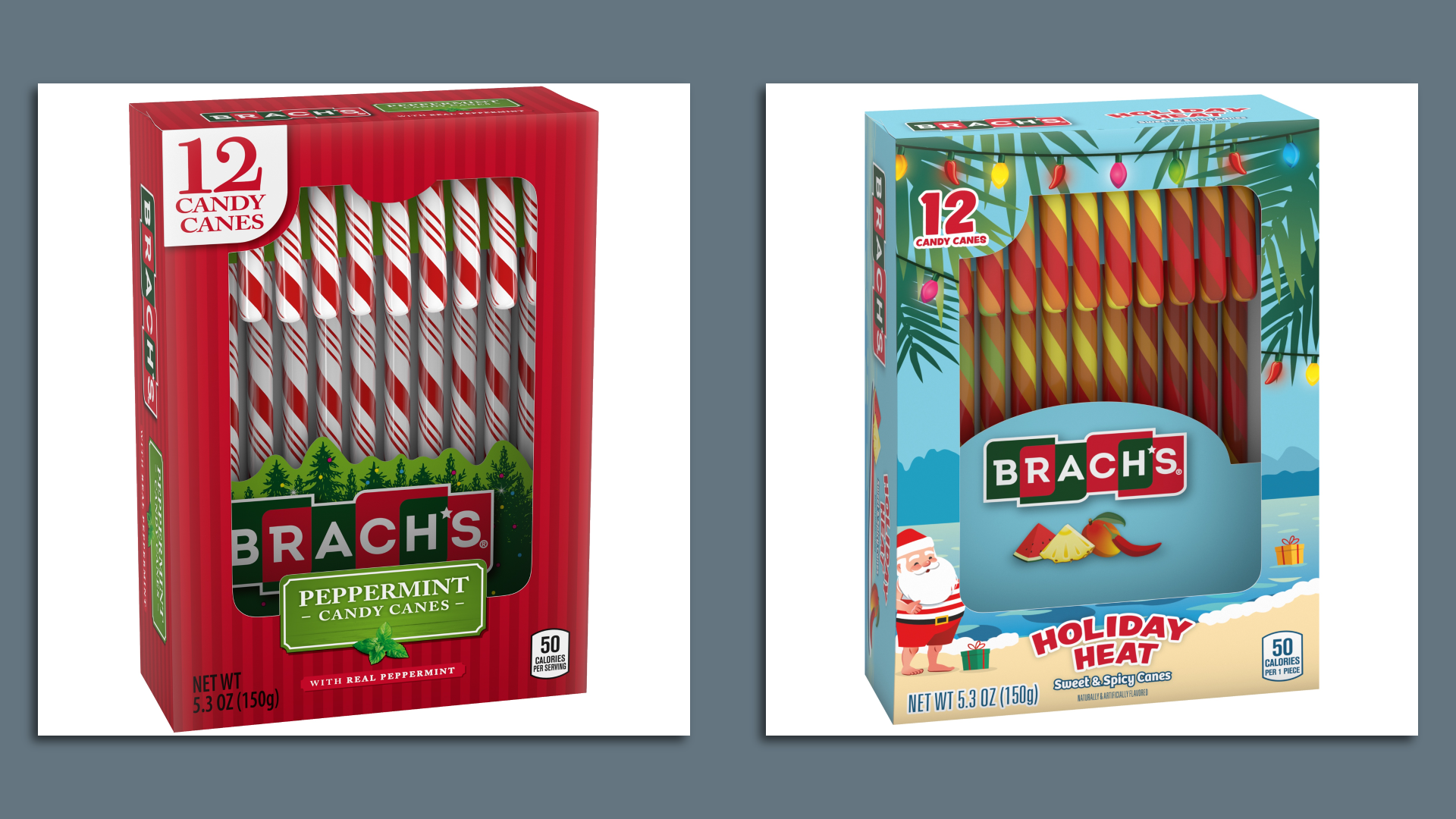Ketchup, Funfetti, brisket, cherry, bubble gum, clove, Twinkies, mango chili, Caesar salad: Candy cane flavors are proliferating as the sugary sticks go from nostalgic favorite to hip retro cult item.
Why it matters: As retailers attempt to amp up iconic holiday symbols and flavors and introduce them earlier in the season — we're looking at you, pumpkin spice — they're building consumer demand for more must-have seasonal products, candy canes included.
Driving the news: The terrifying Candy Cane Shortage of 2021 — caused by a dearth of peppermint oil and other supply chain issues — has eased (thankfully). That's ushering in an explosion of candy cane creativity, much of it having nothing to do with peppermint.
- New products this year include Hostess Twinkies Candy Canes, which are yellow and "creme flavored," and Brach's "Holiday Heat" canes, which come in watermelon chili, mango chili and pineapple chili.
- Last year's new flavor was Funfetti, which has embedded sprinkles and competes with flavors like Nerds, Airheads, Starburst and Skittles.
- Novelty company Archie McPhee sells colorful canes in a variety of gross-out flavors, like hot dog, sardine, butter, mac & cheese, kale and bacon.
- There are even candy cane spoons for stirring hot chocolate or eggnog.
Between the lines: Scarcity and evanescence are part of the appeal. While candy canes are sold year-round, buzzy seasonal products are introduced in "limited editions."
- Dairy Queen's DQ Candy Cane Chill Blizzard Treat and MyMochi's Cool Peppermint are get-'em-while-they-last.
- Delish published a guide to finding Twinkies candy canes (which one reviewer dubbed "this year's questionable holiday snack").
- Canes show up crushed on martini glass rims and in Pepperidge Farm Milanos.
- In an annual holiday tradition, Disneyland's $20 hand-pulled canes have people lining up for hours before the park opens.
The big picture: "Over the past 20-plus years there's been an increasing amount of innovation in candy canes," said Katie Duffy, vice president & general manager of seasonal products at Ferrara, which makes Brach's, the top candy cane brand.
- Still, 72% of Americans prefer classic peppermint candy canes, while 28% would rather try other flavors, per the National Confectioners Association.
- Candy cane sales were up slightly last year, at $108 million compared to $99 million in 2020 and 2019, per IRI data supplied by Ferrara.
What they're saying: "I think everybody's interested in something new," says Andrew Schuman, president of Hammond's Candies, which hand-pulls all its canes.
- The Denver-based confectioner recently introduced organic candy canes, tie-dye cotton candy, and "naughty or nice" (you don't know if you're getting strawberry or black licorice until you start licking).
- "There have been a lot of gimmicks that come through," Schuman tells Axios. "Pickle flavored, ketchup flavored — that's not our style."
- Classics like peppermint, cherry and cinnamon are the brand's top flavors.
Backstory: There's a lot of mythology around candy canes — some believe the shape is meant to represent "J" for Jesus, for instance.
- Most accounts say that a German choirmaster invented the white candy sticks in the 17th century to keep children quiet in church, and bent them into a "J" to represent a shepherd's crook.
- A German-Swedish immigrant in Wooster, Ohio, named August Imgard, who's credited with bringing the Christmas tree to America in 1847, apparently decorated it with candy canes, inaugurating that tradition as well.
The bottom line: 90% of candy canes are sold between Thanksgiving and Christmas.
- But Dec. 26 is National Candy Cane Day — when "open season is declared on all candy canes still hanging from Christmas trees."








